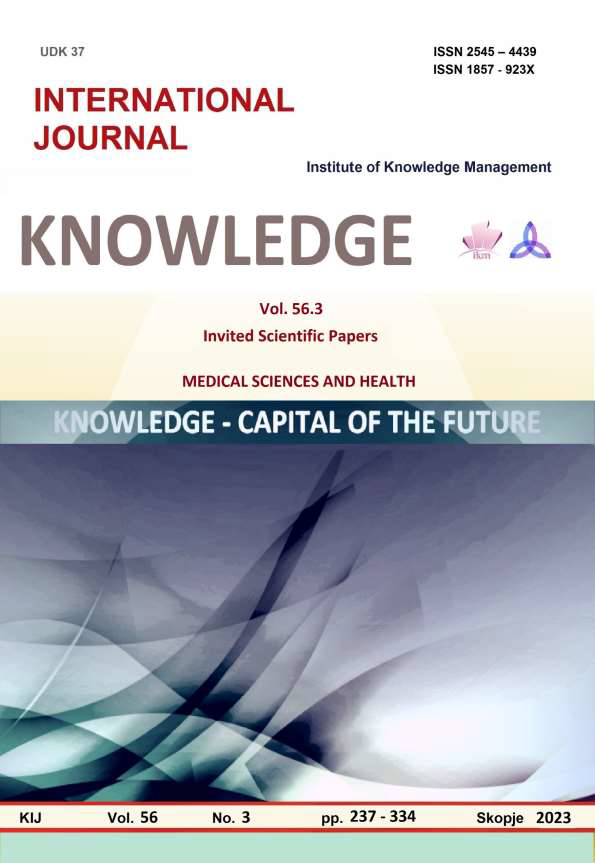METABOLIC SYNDROME AND POLYCYSTIC OVARY
Keywords:
polycystic ovary syndrome, metabolic syndrome, obesity, insulin resistance, hyperandrogenismAbstract
Polycystic ovary syndrome is a heterogeneous endocrine pathology affecting up to 10-15% of women of
reproductive age and is one of the leading causes of infertility in developed countries. Polycystic ovary syndromeе is
associated with many metabolic symptoms, such as obesity, insulin resistance, and hyperandrogenism. Pathogenesis
of these metabolic manifestations is still not fully understood. This can be explained by multiple factors, including
genetic, environmental and lifestyle factors. Polycystic ovary syndrome also shows heterogeneity in metabolic
disorders as well. This supports the hypothesis of the influence of daily lifestyle and diet as well as generated
metabolites on the pathogenesis of Polycystic ovary syndrome. Irving F. Stein and Michael L. Leventhal first
identified this syndrome in 1935 based on the simultaneous presence of polycystic ovaries and anovulation. The
diagnosis of Pоlycystic ovary syndrome is based on three criteria, which are: Rotterdam 2003, Androgen Excess and
Polycystic ovary syndrome Society 2006, and National Institutes of Health Consensus 2012. Among these criteria,
the Rotterdam criteria are the most extensive and widely used. According to these criteria, the diagnosis is based on
three features: clinical or biochemical hyperandrogenism or both, oligo-anovulation, and polycystic ovary
morphology (ultrasound examination showing the presence of ≥12 follicles with a maximum diameter of 2 –9 mm
or any ovarian volume >10 mL). Patients with Polycystic ovary syndrome must meet at least two of the three criteria
and other causes of hyperandrogenism, such as non-classical congenital adrenal hyperplasia, hyperprolactinemia,
and hyperthecosis, must be excluded. Metabolic syndrome is a group of at least three of five cardiometabolic
disorders that occur simultaneously. These include abdominal obesity, hyperglycemia, hypertriglyceridemia, low
high-density cholesterol and hypertension. In practice, the body mass index, graded according to the criteria of the
World Health Organization, is widely used to assess obesity. Metabolic syndrome and polycystic ovary syndrome
are interrelated conditions in which excess androgens are thought to initiate a vicious cycle of metabolic
disturbances in patients with polycystic ovary syndrome. This article aims to focus attention on the precise
assessment of the components of the metabolic syndrome in patients with proven polycystic ovary syndrome and
thus to identify patients with increased cardiometabolic risk and the appointment of appropriate lifestyle changes
and possibly therapeutic interventions.
References
Apridonidze, T., Essah, P.A., Iuorno, M.J., & Nestler, J.E. (2005). 90:1929–1935. Prevalence and characteristics of the metabolic syndrome in women with polycystic ovary syndrome. J. Clin. Endocrinol. Metab.. doi: 10.1210/jc.2004-1045.
Bil, E., Dilbaz, B., Cirik, D.A., Ozelci, R., Ozkaya, E., & Dilbaz, S. (2016). 42:837–843. Metabolic syndrome and metabolic risk profile according to polycystic ovary syndrome phenotype. J. Obstet. Gynaecol. Res. doi: 10.1111/jog.12985.
Cadagan, D., Khan, R., & Amer, S. (2016). 16:53–60. Thecal cell sensitivity to luteinizing hormone and insulin in polycystic ovarian syndrome. Reprod. Biol. . doi: 10.1016/j.repbio.2015.12.006.
Diamanti-Kandarakis, E., & Papavassiliou, A.G. (2006). 12:324–332. Molecular mechanisms of insulin resistance in polycystic ovary syndrome. Trends Mol. Med. . doi: 10.1016/j.molmed.2006.05.006.
Escobar-Morreale, H.F. (2018). 14:270–284. Polycystic ovary syndrome: Definition, aetiology, diagnosis and treatment. Nat. Rev. Endocrinol. doi: 10.1038/nrendo.2018.24.
Gunning, M.N., & Fauser, B. (2017). 20:222–227. Are women with polycystic ovary syndrome at increased cardiovascular disease risk later in life? Climacteric doi: 10.1080/13697137.2017.1316256.
International Diabetes Federation. The IDF consensus, worldwide definition of the metabolic syndrome. 2006.
Lizneva, D., Suturina, L., Walker, W., Brakt,a S., Gavrilova-Jordan, L., & Azziz, R. (2016). 106:6–15. Criteria, prevalence, and phenotypes of polycystic ovary syndrome. Fertil. Steril. doi: 10.1016/j.fertnstert.2016.05.003.
Lujan, M.E., Chizen, D.R., & Pierson, R.A. (2008). 30:671–679.Diagnostic criteria for polycystic ovary syndrome: Pitfalls and controversies. J. Obstet. Gynaecol. Can doi: 10.1016/S1701-2163(16)32915-2.
Milutinović, D.V., Nikolić, M., Veličković, N., Djordjevic, A., Bursać, B., Nestorov, J., Teofilović, A., Antić, I.B., Macut, J.B., Zidane, A.S., et al. (2017). 125:522–529.Enhanced Inflammation without Impairment of Insulin Signaling in the Visceral Adipose Tissue of 5α-Dihydrotestosterone-Induced Animal Model of Polycystic Ovary Syndrome. Exp. Clin. Endocrinol. Diabetes doi: 10.1055/s-0043-104531.
Orio, F., Muscogiuri, G., & Palomba, S. (2015). 69: 974. Could the Mediterranean diet be effective in women with polycystic ovary syndrome? A proof of concept. Eur J Clin Nutr
Pierre, A., Taieb, J., Giton, F., Grynberg, M., Touleimat, S., El Hachem, H., Fanchin, R., Monniaux, D., Cohen-Tannoudji, J., di Clemente, N., et al. (2017). 102:3970–3978. Dysregulation of the Anti-Müllerian Hormone System by Steroids in Women with Polycystic Ovary Syndrome. J. Clin. Endocrinol. Metab. doi: 10.1210/jc.2017-00308.
The Rotterdam ESHRE/ASRM—. 2004;19:41–47. Sponsored PCOS Consensus Workshop Group Revised 2003 consensus on diagnostic criteria and long-term health risks related to polycystic ovary syndrome (PCOS) Hum. Reproddoi: 10.1093/humrep/deh098.
Yilmaz, M., Biri, A., Bukan, N., Karakoç, A., Sancak, B., Törüner, F., & Paşaoğlu, H. (2005). 20:258–263. Levels of lipoprotein and homocysteine in non-obese and obese patients with polycystic ovary syndrome. Gynecol. Endocrinol doi: 10.1080/09513590400027265.
Zlatanova, E. (2021). Frequency of individual nosological units, metabolic syndrome and obesity in patients with adrenal hormonally inactive adenomas and their relationship with anthropometric indicators.DOI: http://dx.doi.org/10.14748/vmf.v0i0.8097
Zlatanova, E. (2021). Metabolic Profile of Patients with Hormone-Inactive Adrenal Adenomas//Метаболитен профил на пациенти с хормонално-неактивни надбъбречни аденоми. PhD Thesis. Medical University of Varna.
Работна група към БИМС. 2010 Консенсус на Българския институт „Метаболитен синдром” за поведение при метаболитен синдром. Наука Ендокринология.





